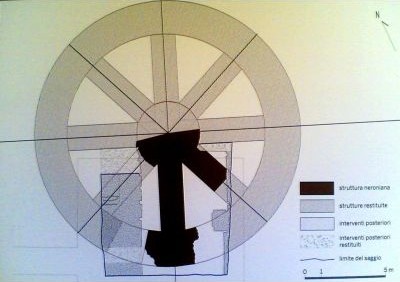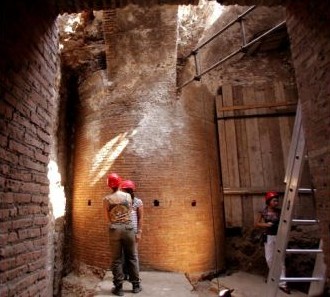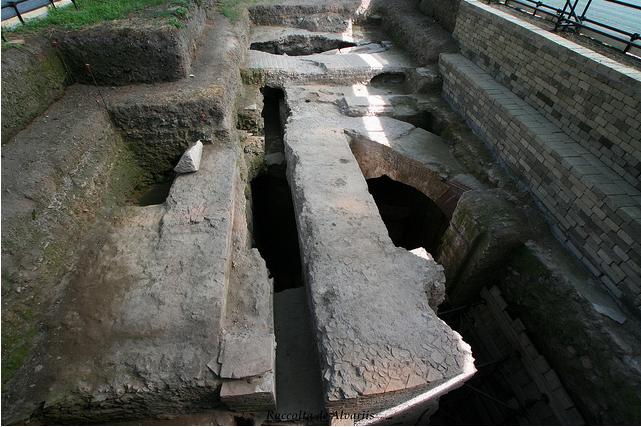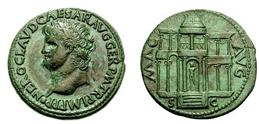Immortal Meals #9: The Discovery of Nero’s Rotating Dining Room? May 17, 2012
Author: Beach Combing | in : Ancient , trackbackBeach’s reading today comes from Suetonius’ Lives of the Caesars, Nero (31)
There was nothing however in which [Nero] was more ruinously prodigal than in building. He made a palace extending all the way from the Palatine to the Esquiline, which at first he called the House of Passage, but when it was burned shortly after its completion and rebuilt, the Golden House. Its size and splendour will be sufficiently indicated by the following details. Its vestibule was large enough to contain a colossal statue of the emperor •a hundred and twenty feet high; and it was so extensive that it had a triple colonnade a mile long. There was a pond too, like a sea, surrounded with buildings to represent cities, besides tracts of country, varied by tilled fields, vineyards, pastures and woods, with great numbers of wild and domestic animals. In the rest of the house all parts were overlaid with gold and adorned with gems and mother-of-pearl. There were dining-rooms [note the plural] with fretted ceils of ivory, whose panels could turn and shower down flowers and were fitted with pipes for sprinkling the guests with perfumes. The main banquet hall was circular and constantly revolved day and night, like the heavens. He had baths supplied with sea water and sulphur water. When the edifice was finished in this style and he dedicated it, he deigned to say nothing more in the way of approval than that he was at last beginning to be housed like a human being.
Non in alia re tamen damnosior quam in aedificando domum a Palatio Esquilias usque fecit, quam primo Transitoriam, mox incendio absumptam restitutamque Auream nominauit. De cuius spatio atque cultu suffecerit haec rettulisse. Uestibulum eius fuit, in quo colossus CXX pedum staret ipsius effigie; tanta laxitas, ut porticus triplices miliarias haberet; item stagnum maris instar, circumsaeptum aedificiis ad urbium speciem; rura insuper aruis atque uinetis et pascuis siluisque uaria, cum multitudine omnis generis pecudum ac ferarum. In ceteris partibus cuncta auro lita, distincta gemmis unionumque conchis erant; cenationes laqueatae tabulis eburneis uersatilibus, ut flores, fistulatis, ut unguenta desuper spargerentur; praecipua cenationum rotunda, quae perpetuo diebus ac noctibus uice mundi circumageretur; balineae marinis et albulis fluentes aquis. Eius modi domum cum absolutam dedicaret, hactenus comprobauit, ut se diceret quasi hominem tandem habitare coepisse.
‘And constantly revolved like the heavens…’? So those impressive Roman architects actually managed to create a rotating room: memories of a folding ampitheatre in Pliny. Certainly, this is what Suetonius claims and Suetonius is demonstrably right about many details from Nero’s catastrophic reign. (He’s also wrong about a few but let’s not go there yet…) The Roman historian was, after all, writing a mere generation after Nero had been kebbabed and rotating dining rooms are difficult to forget.
But there is more. In the fall of 2009 French archaeologists working in Rome announced that they had discovered the missing dining room. The news had its star burst through the media, getting on to the first or second pages of many of the world’s most important papers. But it is, let’s face it, relatively easy to convince some unshaven journalists from the New York Times and Spiegel that you’ve struck gold. If it later transpires that you’ve done nothing of the sort don’t count on the same to publish a retraction: unless, of course, you’ve convinced them to serialize Hitler’s diaries…
So what was discovered in Rome? The archaeologists first found a massive circular pillar that was about four metres in diameter and about ten metres high encased in bricks: the ‘pillar’ is buttressed by strong arches. Above there was a platform (picture at head of post) that was sixteen metres across and there are three quarter metre cavities in the floor of this platform which could conceivably have held a rotating surface. It has been suggested that the pillar was moved by hydro-power and that a tower made of wood was built on the rotating structure. Or were there one hundred and fifty human hamsters jerking Nero and his diners round? Beachcombing is not very good at engineering: drbeachcombing AT yahoo DOT com
Well, Beach, sceptic that he is, took for granted that this structure was not actually the rotating dining room. But after combing through the arguments for and against this morning, he started to get excited. The structure clearly had an unusual function. The pillar was supposedly built after the fire of Rome, so the date synchs. The site offers a panorama of Rome, just right for a rotating room. And it would, likely, have been in the area once covered by the Golden House, the Domus Aurea. There have even been attempts to ‘spot’ the tower on a Neronian coin!
The only striking argument against is the relatively small size of any rotating superstructure: after all, how many diners can you get in a room with no more than a sixteen-metre diameter? Perhaps though this was just a case of Roman technology not being able to do more.
Interestingly, the sovrintendenza is presently allowing guided tours to the ‘dining room’ and the description (in Italian) while sensibly cautious is still, three years on, pushing Nero and his clouds of rose petals for all they are worth.
***
18 May 2012: First up is Mark who bats away the coin theory: Doc, I’m very curious about the origin of a speculation voiced in today’s blog entry and what it might have been based upon. Specifically this would be the inference that the central portion of the reverse of Nero’s Macellum Magnum Dupondius might be portraying something related to revolving dining room(s) in the Domus Aurea. It has been accepted for centuries that this coin’s reverse shows a frontal elevation of the Macellum on the Caelian Hill. The Romans’ tentative grasp of perspective would have to be at fault if the column supporting the front of the central dome of this building is being seen, somehow, as a vertical hub. Any interpretation of this feature as a portrayal of a rotating structure would certainly be revolutionary. It is definitely not a theory for which any support is currently widely held. To the best of my knowledge, this theory is not one about which anyone known to me sho studies coins or the history of the era has ever heard.’ For what it is worth Beach shares the scepticism and here is the (Italian language) reference to that coin and the rotating tower. And the relevant passage ‘ La Villedieu [the leader of the excavation] mette sul tavolo anche una moneta d’età neroriana in cui appare un edificio particolare. «Le lettere MAC secondo alcuni vogliono dire Macellum ma per altri Machina. E Machina Augusti potrebbe essere la “nostra” coenatio. Nella moneta si vede un corpo centrale ed è possibile che sopra ci fosse il piano rotante». Villedieu [the excavation head] has also brought up a Neronian coin on which a peculiar building appears. ‘The letters MAC mean, according to some, Macellum, but for others mean Machina and Machina Augusti could be ‘our’ dining room. On the coin you see a central body and it is possible that above that there is the rotating plane.’ SY meanwhile offers this site and its excellent photographs for anyone who wants to get down and dirty with the engineering. Thanks Mark and SY. SY meanwhile offers this site and its excellent photographs. http://ilfattostorico.com/2009/09/29/la-coenatio-rotunda-di-nerone/
9 June 2012: Huge thanks to Prof Françoise Villedieu, the mover and shaker of the campaign to get the site recognised as the turning dining room of big bad Nero. Beach translates from the French: There has been very great interest, and I only regret that the funding bodies, who could give money to further investigations, have not been forthcoming. Since 2009, I have tried many strategies and projects to get financing and I’ve not yet had much success. I can offer the following article for those of your readers who would like to read more: Une construction néronienne mise au jour sur le site de la Vigna Barberini : la cenatio rotunda de la Domus Aurea? This appeared in Neronia electronica, fasc. 1, 2011, p. 37-52. There you will find many details : perhaps too many!!’ Many, many, many thanks to the good Professor and if Beach has anyone who has a spare million in the Professor’s direction please do get in touch.






